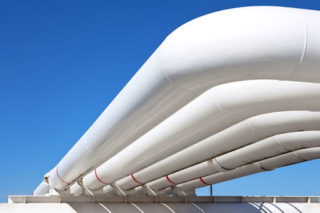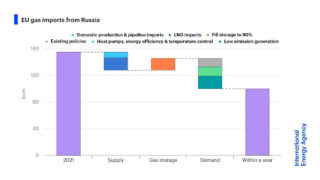-
IEA suggests a suite of measures for the European Union to reduce its imports of Russian gas by more than one-third within a year
Date posted:
-
-
-
Post Author
Greg Kelsall
-
-
![]()
The IEA has proposed a combination of actions covering gas supplies, the electricity system together with end-users, which could support the European Union’s energy security and affordability, and which it says are consistent with the European Green Deal.
The report called A 10-Point Plan to Reduce the European Union’s Reliance on Russian Natural Gas – proposes a coordinated approach to minimise the impact of Russian sanctions on society.
In 2021, the EU imported an average of over 380 million cubic metres per day of gas by pipeline from Russia, or around 140 billion cubic metres (bcm) per year. In addition, around 15 bcm was delivered in the form of liquefied natural gas (LNG). This total Russian imported gas of 155 bcm accounted for around 45% of the EU’s gas imports in 2021 and almost 40% of its total gas consumption.
Adopting its proposed ten steps could reduce the EU’s imports of Russian gas by over a third within a one year timeframe, according to the report. This also takes into account the need for additional refilling of European gas storage facilities in 2022.
The IEA’s ten recommendations are defined as :
- No new gas supply contracts with Russia- Impact: enable greater diversity of supply by taking advantage of expiring long-term contracts.
- Replace Russian supplies with gas from alternative sources- Impact: around 30 bcm in additional gas supply from non-Russian sources.
- Introduce minimum gas storage obligations to enhance market resilience- Impact: enhances resilience of the gas system, although higher injection requirements to refill storage in 2022 will add to gas demand, maintaining gas prices.
- Accelerate the deployment of new wind and solar projects- Impact: an additional 35 TWh of generation from new renewables over the next year, over and above the already anticipated growth from these sources, bringing down gas use by 6 bcm.
- Maximise power generation from existing dispatchable low emissions sources of bioenergy and nuclear- Impact: an additional 70 TWh of power generation from existing sources, reducing gas use for electricity by 13 bcm.
- Enact short-term measures to shelter vulnerable electricity consumers from high prices-
Impact: Bring down energy bills for consumers even when natural gas prices remain high, making available up to €200b to cushion impacts on vulnerable groups. - Speed up the replacement of gas boilers with heat pumps- Impact: reduces gas use for heating by an additional 2 bcm within one year.
- Accelerate energy efficiency improvements in buildings and industry- Impact: reduces gas use for heat by close to 2 bcm within one, enhancing comfort and boosting industrial competitiveness.
- Encourage a temporary thermostat reduction by consumers- Impact: turning down building thermostats by 1°C reduces gas demand by some 10 bcm.
- Step up efforts to diversify and decarbonise sources of power system flexibility- Impact: A major near term push on innovation can loosen the strong links between natural gas supply and Europe’s electricity security.
“Nobody is under any illusions anymore. Russia’s use of its natural gas resources as an economic and political weapon show Europe needs to act quickly to be ready to face considerable uncertainty over Russian gas supplies next winter,” said IEA Executive Director Fatih Birol.
However, its analysis highlights some trade-offs. While accelerating investment in clean and efficient technologies forms a major component of the solution, it said even very rapid deployment of these technologies would take time to make a major dent in demand for imported gas. “The faster EU policy makers seek to move away from Russian gas supplies, the greater the potential implications in terms of economic costs and/or near-term emissions. Circumstances also vary widely across the EU, depending on geography and supply arrangements,” the agency said.
![]()
Proposed reduction measures of the EU’s gas imports from Russia (IEA)
Overall, the plan seems reasonable, although some of the proposed measures such as increasing wind and renewables by 35 TWh may be more aspirational. The 10-point plan however does not mention coal, where a number of European countries are already looking to push back on the proposed dates of coal phase out and re-open closed coal power plant in an attempt to reduce Russian gas imports whilst maintaining security of supply. The IEA do however indicate that deeper cuts of Russian gas imports are possible, with the main near-term option involving a switch away from gas use in the power sector via an increased call on Europe’s coal-fired fleet or by using alternative fuels, primarily liquid fuels, within existing gas-fired power plants. Given that these alternatives to gas use would raise the EU’s emissions, they are not included in the 10-Point Plan described above.


